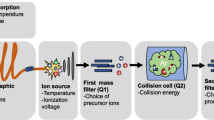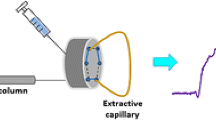Abstract
Background, aim, and scope
In papermaking, there is a continuous interest both to minimize fresh water consumption and to reduce discharges into the environment. These general trends mean an increase in the amounts of detrimental substances, such as resin and fatty acids, in papermaking process waters. Resin acids, in particular, are responsible for much of the toxicity typically present in paper mill effluents and, for this reason, the routine and rapid monitoring of these compounds in various process streams is necessary. This also means that there is a continuous need to develop straightforward offline and online techniques to clarify problems occurring, for example, as a result of the introduction of more intensively closed systems of water circulation. In the present study, we describe the use of a novel, online, sample enrichment technique followed by atmospheric pressure chemical ionization–mass spectrometry (APCI-MS) suitable for monitoring the concentration levels of common resin and fatty acids in papermaking process waters.
Materials and methods
The representative process water samples were taken from the grinding zone of a thermomechanical pulping mill. The samples were first preconcentrated in a precolumn C18, and the analytes were transferred online to MS. The high intensive [M–H]− ion was used for the identification of each analyte since, according to the present ionization method, no other fragmentation was observed. Laboratory-scale, online measurements with an online sample feed were carried out by connecting a centrifugal pump and a ceramic filter to the APCI-MS.
Results
Quality parameters, such as repeatability, linearity, and limit of detection (LOD), were determined by using dehydroabietic acid (DHAA) in order to evaluate the suitability of the method for the rapid screening of concentration levels. This method provided satisfactory linearity and a good correlation between analyte concentration and peak area. The suitability of the system for the continuous analysis of the same acids was evaluated in laboratory-scale, online experiments. In all cases, the response to changes in the analyte concentration was linear, and the repeatability of the system was also satisfactory.
Discussion
Only a few studies have been published on the analysis of resin and fatty acids with MS techniques. The present method was applied to the monitoring of dehydroabietic, oleic, and stearic acids. The quality parameters were highly comparable with those reported earlier, and the LOD values of the DHAA were below the levels usually encountered in process waters. The quality parameters were only slightly higher than those obtained by the traditional methods of analysis, probably due to the absence of an effective sample clean-up before analysis.
Conclusions
The results of the laboratory-scale, online experiments indicated that the online enrichment APCI-MS system is a suitable alternative for monitoring the concentration levels of selected resin and fatty acids in papermaking process waters. The method can be used, for example, to provide useful information about the concentration levels of these acids in different stages of the process, thus signaling possibly impending problems. In general, faster and simpler measurements are needed to meet the requirements for a reduction in fresh water usage in papermaking.
Recommendations and perspectives
Compared to the conventional methods used for this purpose, the main benefits of the method are rapidity of measurement, simplicity of use, and absence of the need for multistage sample treatments (short analysis time). For this reason, this online method is more suitable for the control of papermaking by analyzing the concentration levels of interfering substances (i.e., selected resin and fatty acids) than an offline analysis detailing all the individual extractives-based compounds in process streams. It is also obvious that the technique can easily be modified for other environmental pollutants as well.


Similar content being viewed by others
References
Chow SZ, Shepard D (1996) High performance liquid chromatographic determination of resin acids in pulp mill effluent. Tappi J 79:173–179
Destandau E, Vial J, Jardy A, Hennion MC, Bonnet D, Lancelin P (2005) Development and validation of a reversed-phase liquid chromatography method for the quantitative determination of carboxylic acids in industrial reaction mixtures. J Chromatogr A 1088:49–56
Dethlefs F, Stan H-J (1996) Determination of resin acids in pulp mill EOP bleaching process effluent. Fresenius J Anal Chem 356:403–410
Hennion M-C (1999) Solid-phase extraction: method development, sorbents, and coupling with liquid chromatography. J Chromatogr A 856:3–54
Holmbom B (1999) Analysis of papermaking process waters and effluents. In: Sjöström E, Alén R (eds) Analytical methods in wood chemistry, pulping, and papermaking. Springer, Berlin, pp 269–285
Kokkonen R, Sirén H, Kauliomäki S, Rovio S, Luomanperä K (2004) On-line process monitoring of water-soluble ions in pulp and paper machine waters by capillary electrophoresis. J Chromatogr A 1032:243–252
Lahdelma I, Oikari A (2005) Resin acids and retene in sediments adjacent to pulp and paper industries. J Soils Sediments 5:74–81
Latorre A, Rigol A, Lacorte S, Barceló D (2003) Comparison of gas chromatography-mass spectrometry and liquid chromatography-mass spectrometry for the determination of fatty and resin acids in paper mill process waters. J Chromatogr A 991:205–215
Latorre A, Rigol A, Lacorte S, Barceló D (2005) Organic compounds in paper mill wastewaters. In: Hutzinger O (ed) The handbook of environmental chemistry. vol. 5. Springer, Berlin, pp 25–51
Lee H-B, Peart TE, Carron JM (1990) Gas chromatographic and mass spectrometric determination of some resin and fatty acids in pulpmill effluents as their pentafluorobenzyl ester derivates. J Chromatogr 498:367–379
McMartin DW, Peru KM, Headley JV, Winkler M, Gillies JA (2002) Evaluation of liquid chromatography-negative ion electrospray mass spectrometry for the determination of selected resin acids in river water. J Chromatogr A 952:289–293
Miller JC, Miller JN (1993) Statistics for analytical chemistry, 3rd edn. Ellis Horwood, Chichester
Mosbye J, Harstad B, Fiksdahl A (2000) Solid phase extraction (SPE) of hydrophobic components from a model white water. Nord Pulp Pap Res J 15:101–105
Örså F, Holmbom B (1994) A convenient method for the determination of wood extractives in papermaking process waters and effluents. J Pulp Pap Sci 20:J361–J366
Peng G, Roberts JC (2000a) An improved method for analysing resin acid in wood, pulp, process water, and effluent samples. Tappi J 83:80–81
Peng G, Roberts JC (2000b) Formation of resin acids during thermomechanical pulping. Appita 53:49–53
Peng G, Roberts JC (2000c) Solubility and toxicity of resin acids. Wat Res 34:2779–2785
Rigol A, Lacorte S, Barceló D (2003a) Sample handling and analytical protocols for analysis of resin acids in process waters and effluents from pulp and paper mills. Trends Anal Chem 22:738–749
Rigol A, Latorre A, Lacorte S, Barceló D (2003b) Direct determination of resin and fatty acids in process waters of paper industries by liquid chromatography/mass spectrometry. J Mass Spectrom 38:417–426
Robinson MJ, Anderson SM, Judd MC, Stuthridge TR (1999) Advanced extraction techniques for the analysis of pulp and paper matrices. In: 53rd Appita Annual Conference, Rotorua, April 1999, pp 765–771
Slobodník J, Louter AJH, Vreuls JJ, Liška I, Brinkman UATh (1997) Monitoring of organic micropollutants in surface water by automated on-line trace enrichment liquid and gas chromatographic systems with ultraviolet diode-array and mass spectrometric detection. J Chromatogr A 768:239–258
Smith GA, Lloyd TL (1998) Automated solid-phase extraction and sample preparation—finding the right solution for your laboratory. LC-GC 5:S22–S31
Valto P, Knuutinen J, Alén R (2007) Resin and fatty-acid analysis by solid-phase extraction coupled to atmospheric pressure chemical ionization-mass spectrometry. Int J Environ Anal Chem 87:87–97
Voss RH, Rapsomatiotis A (1985) An improved solvent-extraction based procedure for the gas chromatographic analysis of resin and fatty acids in pulp mill effluents. J Chromatogr 346:205–214
Wissiack R, Rosenberg E, Grasserbauer M (2000) Comparison of different sorbent materials for on-line solid-phase extraction with liquid chromatography-atmospheric pressure chemical ionization mass spectrometry of phenols. J Chromatogr A 896:159–170
Acknowledgment
For financial support, the authors wish to thank the National Technology Agency (Tekes), the Science Park of Jyväskylä, KCL Science and Consulting, UPM-Kymmene Oyj, Kemira Chemicals, Metso, the Finnish Ministry of Education, and Magnus Ehrnrooth Foundation. Special thanks are due to Mrs. Jaana Käkölä for her skillful assistance with the APCI-MS analyses.
Author information
Authors and Affiliations
Corresponding author
Additional information
Responsible editor: Peter Luthardt
Rights and permissions
About this article
Cite this article
Valto, P., Knuutinen, J. & Alén, R. Evaluation of resin and fatty acid concentration levels by online sample enrichment followed by atmospheric pressure chemical ionization-mass spectrometry (APCI-MS). Environ Sci Pollut Res 16, 287–294 (2009). https://doi.org/10.1007/s11356-008-0050-z
Received:
Accepted:
Published:
Issue Date:
DOI: https://doi.org/10.1007/s11356-008-0050-z




